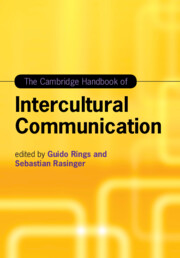Book contents
- The Cambridge Handbook of Intercultural Communication
- Cambridge Handbooks in Language and Linguistics
- The Cambridge Handbook of Intercultural Communication
- Copyright page
- Contents
- Figures
- Tables
- Contributors
- Acknowledgements
- Introduction
- Part I Introducing Intercultural Communication
- Part II Theoretical Approaches
- 5 Critical Intercultural Communication and the Digital Environment
- 6 From Shared Values to Cultural Dimensions
- 7 Towards Integrative Intercultural Communication
- 8 The Power of Literature in Intercultural Communication
- 9 Psychoanalytic Approaches to Memory and Intercultural Communication
- 10 Sociological Approaches to Intercultural Communication
- 11 Introducing Intercultural Ethics
- Part III Methods
- Part IV Application
- Part V Assessment
- Index
- References
5 - Critical Intercultural Communication and the Digital Environment
from Part II - Theoretical Approaches
Published online by Cambridge University Press: 18 February 2020
- The Cambridge Handbook of Intercultural Communication
- Cambridge Handbooks in Language and Linguistics
- The Cambridge Handbook of Intercultural Communication
- Copyright page
- Contents
- Figures
- Tables
- Contributors
- Acknowledgements
- Introduction
- Part I Introducing Intercultural Communication
- Part II Theoretical Approaches
- 5 Critical Intercultural Communication and the Digital Environment
- 6 From Shared Values to Cultural Dimensions
- 7 Towards Integrative Intercultural Communication
- 8 The Power of Literature in Intercultural Communication
- 9 Psychoanalytic Approaches to Memory and Intercultural Communication
- 10 Sociological Approaches to Intercultural Communication
- 11 Introducing Intercultural Ethics
- Part III Methods
- Part IV Application
- Part V Assessment
- Index
- References
Summary
Thomas Nakayama discusses the importance of ‘critical intercultural communication’, i.e. an approach that he has proposed, defined and very substantially developed, with particular regard for interactions in an environment increasingly shaped by Facebook, Twitter, Instagram and Snapchat. Since, despite the rise of the network society, overall little attention has been paid to the ways that social media influence intercultural communication, the chapter introduces examples that allow for an in-depth exploration of the ways that social inequality is reinforced in the digital environment, as well as the ways that people utilize social media to resist that inequality.
Keywords
- Type
- Chapter
- Information
- The Cambridge Handbook of Intercultural Communication , pp. 85 - 95Publisher: Cambridge University PressPrint publication year: 2020
References
- 3
- Cited by

